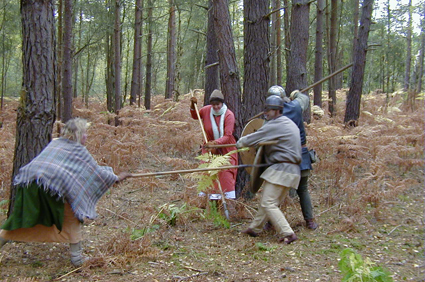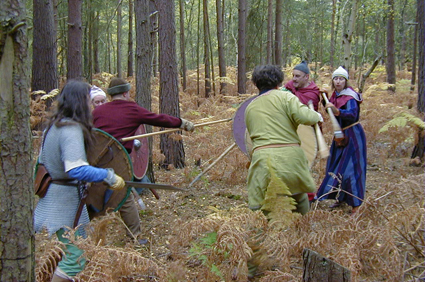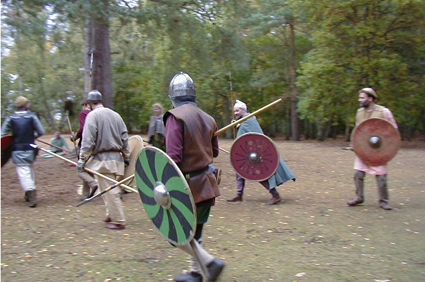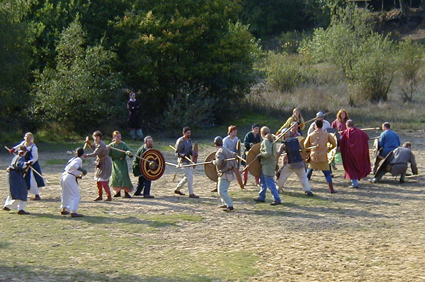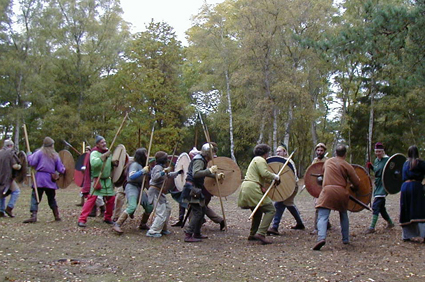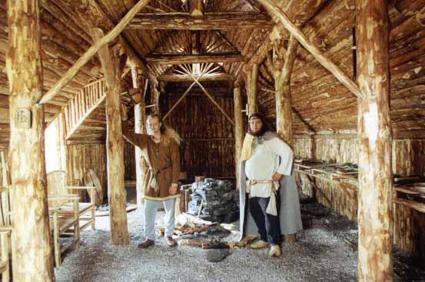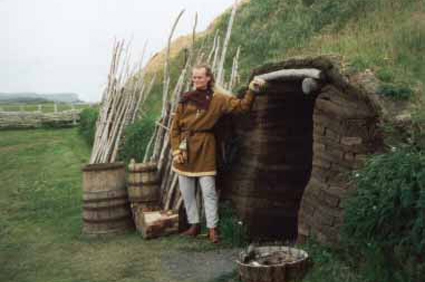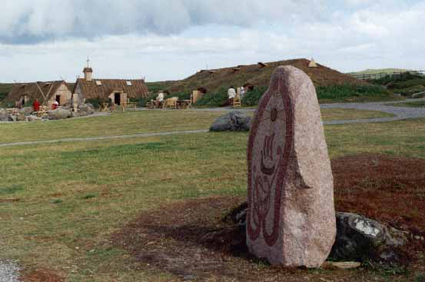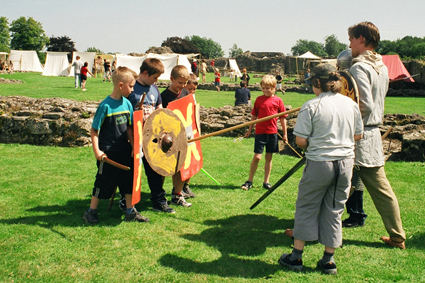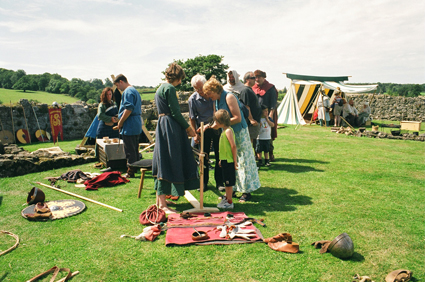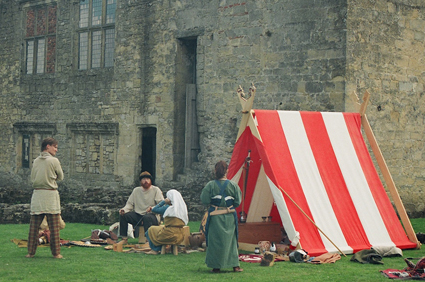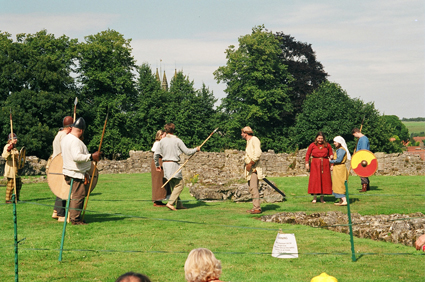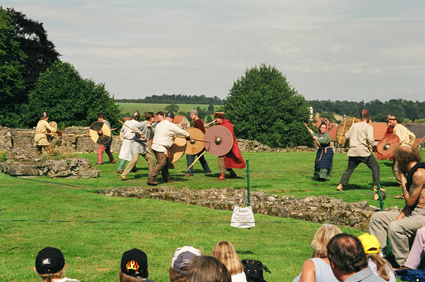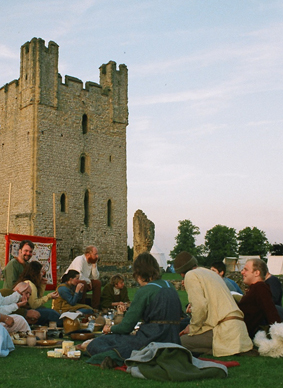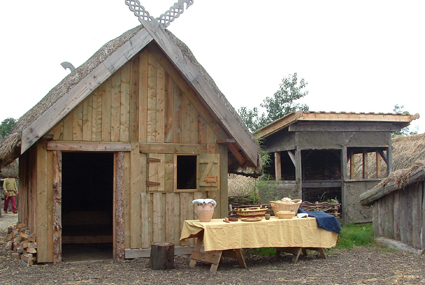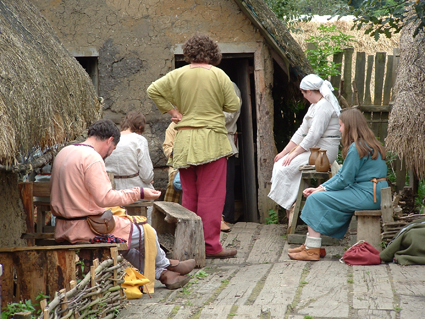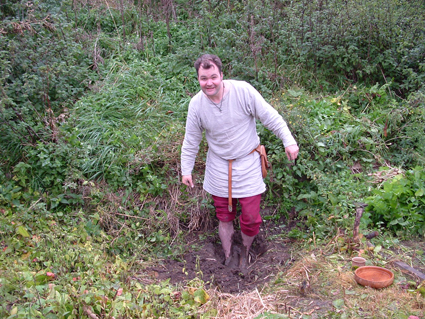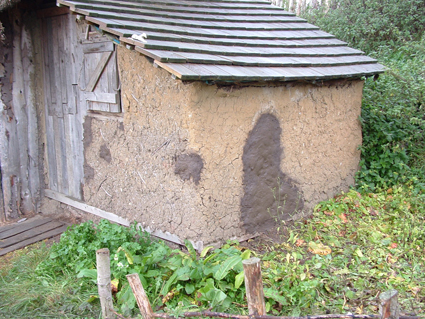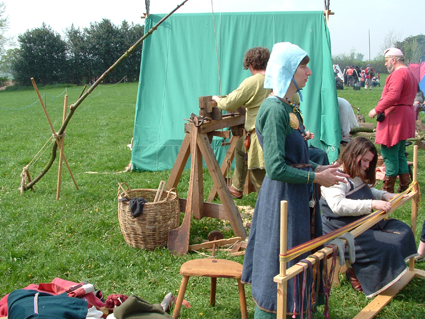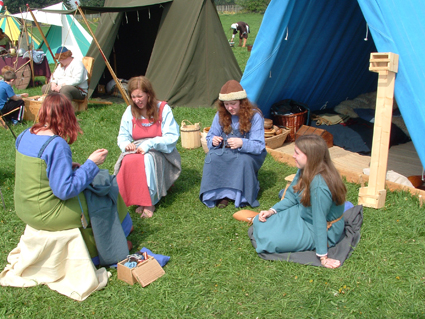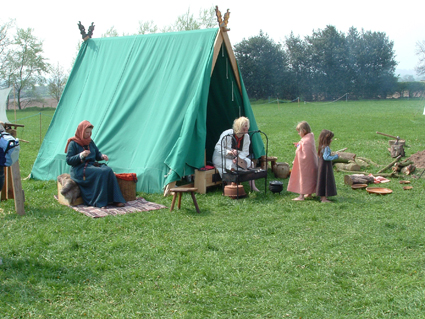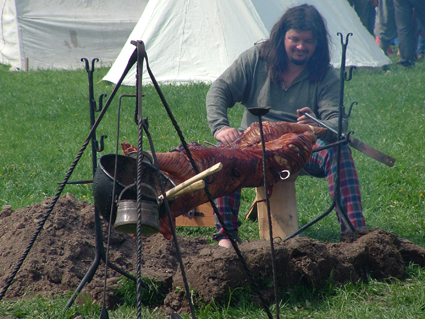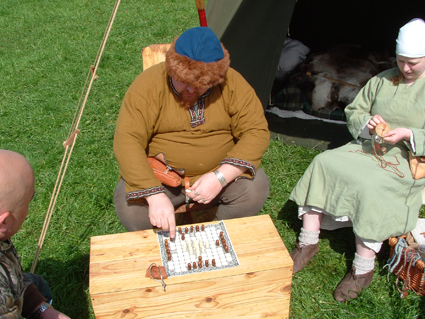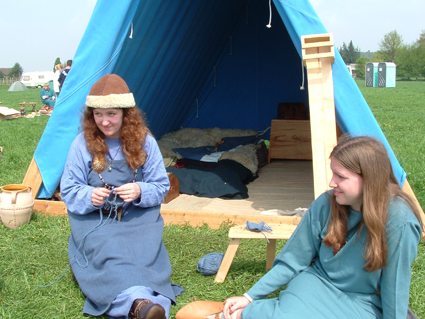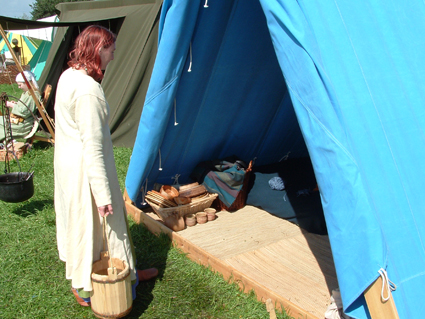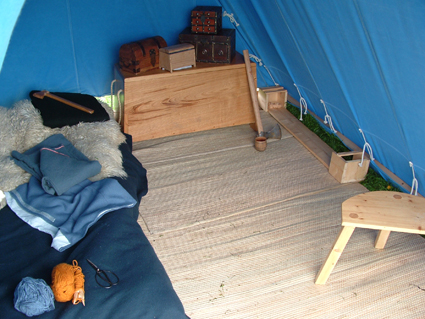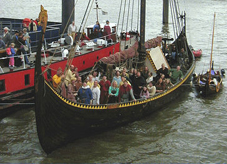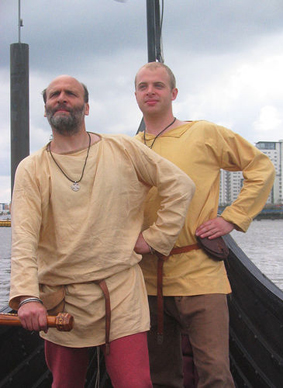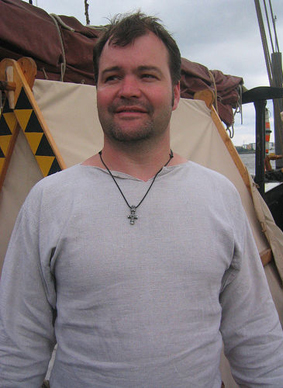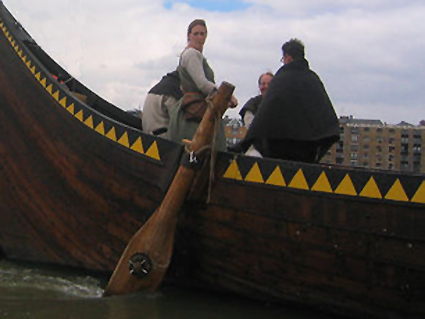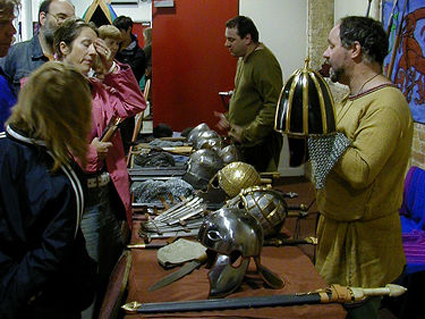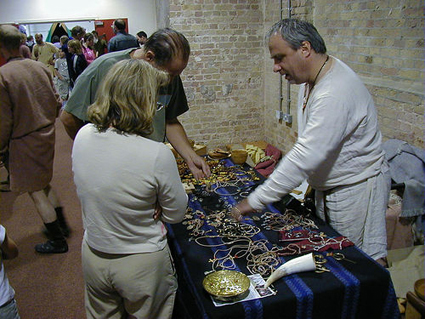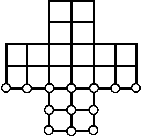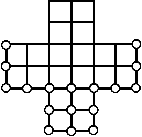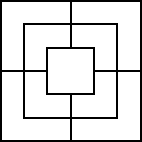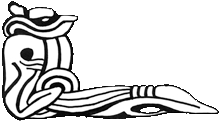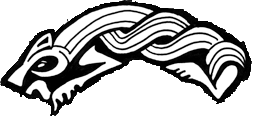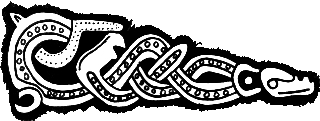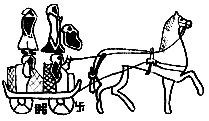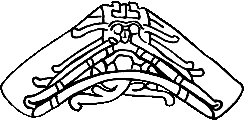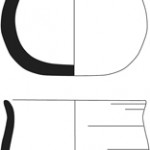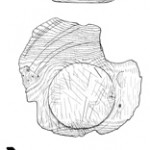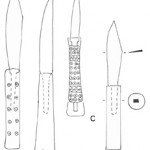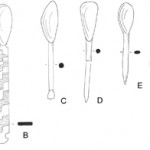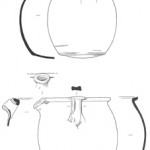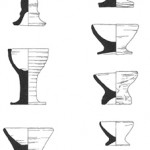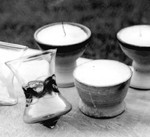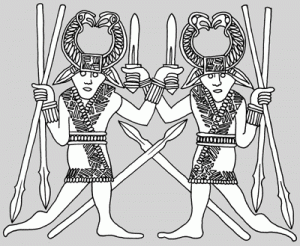
Most Saxons and Vikings wore the standard woollen overtunics that we all know and love, however this was not a universal style. This article will examine the evidence we have for four different styles of coats- the early Germanic “warrior jacket”, the two cuts of Eastern Viking kaftans and finally the female coat.
Obviously kaftans aren’t appropriate for all DAS characters. The warrior jacket was primarily popular before our period; the two kaftans are distinctively Eastern so should probably be used to draw attention to particular ethnicities or as a sign of having travelled in the Rus lands; and the female coat may never have even existed.
The Wrap-Around “Warrior” Jacket (Early Germanic)
History: Jackets with triangular overlapping front panels, possibly made of fur, are found in several sources. The Franks seem to have worn them waist-length, according to the Einhard’s description of Charlemagne and Hrabanus Maurus’s illustration of Louis the Pious. Meanwhile longer overlapping coats are illustrated on the Sutton Hoo and Swedish Vendel-period helmet plaques.
There are also tantalising hints of them in the archaeological evidence. There have been several fragments from Hedeby that have been interpreted as triangular front panels, whilst at Birka there are regularly penannular broaches or ringed pins found at hip-level. In 7th-century Saxon sites there have been several finds of tablet weaving running down the front of the body, which have been interpreted as edge decoration on a warrior jacket.
Thus it seems that the wrap-around jacket was popular fairly universally in Germanic areas, however by our period it is rather old-fashioned (if it exists at all). Precisely how the jacket came to Europe has not been ascertained: it is possible that it was adopted from nomadic tribes, or from the Near East by officers serving in the Late Roman Army, or from early expeditions Eastwards. The Sutton Hoo helmet was probably manufactured in Sweden, so it is possible that the wrap-around jacket also indicates Swedish links.
Design: The wrap-around jacket can be as long as a tunic, or can be shorter. It should probably be cut much like a tunic, with a simple rectangular back panel and separate arms (with standard under-arm gussets). However the normal rectangular front panel is replaced with two panels, both as wide as the back panel at the bottom but with diagonally cut front edges running up to the neck. There is generally no need to have side gussets with this design, but they can be added.
It can be held shut with a belt or with pins at hip-level. The panels are illustrated overlapping in both directions, although wearer’s left-over-right seems the most popular.
The jacket is often depicted with decoration on all the edges and at the cuffs- this could indicate embroidery, tablet-woven braid or fur trim.
Accessories: In some of the helmet plates the figures wearing this jacket also wear strange horned helmets, tipped with what could be ravens’ heads. They also tend to carry spears. As ravens and spears are both strongly associated with Odin, some people have suggested this means the wrap-around jacket had ritual significance.
Resources:
- Historiska Världar is a Swedish site, with pictures and patterns of a wrap-around jacket. Their design is rather more tailored than I’d use. http://histvarld.historiska.se/histvarld/draekter/vherreman/kaftan.html
- Penelope Walton Rogers’s Cloth and Clothing in Early Anglo-Saxon England (p.210-214) has an excellent discussion about the jacket, especially about English finds and possible origins. Ceolred Monger Thane may still have some copies of this book for sale.
- Meanwhile, Thor Ewing’s Viking Clothing (p.110-112) discusses the Viking and Frankish evidence for the warrior jacket. He calls it a “thorax”.
The Asymmetrical Riding Coat (Alannic, possibly also Rus?)
History: The nomadic Turkic cultures throughout Asia wore long caftan/kaftan/deel riding coats, as did some settled Iranian/Persian cultures. These were typically asymmetrical, with overlapping front panels. East Asian groups like the Mongols wore them with the opening on the wearer’s right; most people wore them with the opening on the left.
In Ibn Fadlan’s Risala he says the Rus wear “neither tunics nor caftans, but the men wear a garment which covers one side of the body and leaves a hand free” (i.e. just a cloak). However when describing the ship-burning funeral of a Rus king, he reports that “they dressed him in trousers, stockings, boots, a tunic, and kaftan of brocade with gold buttons. They put a hat of brocade and fur on him”. This suggests that standard clothes for the Rus might have been just a cloak, but that rich Rus also owned kaftans.
But what style kaftans would the Rus have worn? We’re not sure. But we do know what their neighbours wore. We are lucky that there have been a number of finds of Alan kaftans dating from our period, the 9th/10th centuries. As the Alans were one of the tribes the Rus Vikings would have had to contend with on the southern borders of their realm (the Byzantines are south of the Black Sea, the Alans are East, the Khazars are North-East and the Rus are North), there is a strong chance that Rus who had adopted a native style would have worn something similar to these Alans.
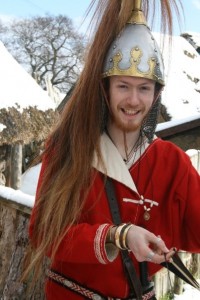
Design: The Alan kaftans are generally quite similar to each other. These all feature asymmetrical openings on the left, single lapels (on the outer panel), no standing collars and cloth frogs. They are cut with large underarm gussets- sometimes really obscenely large underarm gussets. They also have two slits down the back, from waist height to the bottom, allowing plenty of movement. The ‘skirt’ is cut separately from the ‘shirt’ and then attached. They are normally lined (often with fur), and feature bands of decoration down all exposed edges.
Frogging (cloth buttons and loops) seems to have spread from cultures in contact with the Khazars- such as the Bulgars, Alans and presumably also the Rus.
Accessories: Ibn Fadlan isn’t the only source to discuss Rus costume. The Hudud al-‘Alam (a 10th century geographical encyclopaedia) says about the Rus: “Out of 100 cubits of cotton fabric, more or less, they sew trousers which they put on, tucking them up above the knee. They wear woollen bonnets with tails let down behind their necks.” Ibn Rusta goes even further, and says they use 100 cubits per leg in their trousers! The Gotland picture-stones show these baggy trousers as generally knee-length, although some show them as ankle-length.
Taking these three sources together, the most distinctive Rus costume could include boots, exceedingly baggy trousers, asymmetrical kaftans and long pointy hats (decorated with fur or brocade). Of course, this could well be just the very best banqueting kit and everyday Rus kit was probably less extreme and more similar to standard Viking kit.
Rus Viking bling probably included silver granulated beads (found in hoards in Gotland as well as in Moscow) and belt decorations (common among nomadic groups in that part of Asia).
Resources:
- The Metropolitan Museum of Art has a lovely Alan linen-with-silk-trimmings kaftan which they published two excellent articles about in the Metropolitan Museum Journal Vol. 36 (2001). The first article is a conservator’s guide to the physical item including a pattern and photos of similar ones, and the second article is a guide to the historical context discussing kaftans across Asia. The articles are highly recommended. The kaftan is also shown on their website at: http://www.metmuseum.org/toah/ho/06/waa/ho_1996.78.1.htm
- The State Hermitage Museum has an even more spectacular Alan full-silk kaftan: http://www.hermitagemuseum.org/html_En/03/hm3_5_12a.html
- Peter Beatson of Miklagard in the New Varangian Guard has a wonderful set of Rus kit. He uses a symmetrical Birka-style kaftan (see below) rather than the cut discussed here, but he includes a pattern for this style. His pattern is a bit simpler than the Metropolitan Museum’s pattern, and looks good: http://www.miklagard.nvg.org.au/costume/rus/trader/rus_main.htm
- Thor Ewing’s Viking Clothing (p.108-109) discusses kaftans.
Symmetrical Birka-style Kaftan (Swedish/Gotlandic)
History: As well as the asymmetrical style of kaftan, there is also the centre-opening style. This is possibly a more Iranian-Islamic cut.
This design seems to have become popular among Swedish Vikings, and there have been several possible finds of symmetrical coats in Viking contexts. A complete Viking kaftan has not yet been recovered, however several graves at Birka have featured central lines of cast bronze buttons (from 4-24 of them) from neck to waist. There are also some beautifully embroidered cuffs and a collar from Valsgärde graves 12 and 15 that may have been mounted on symmetrical coats originally.
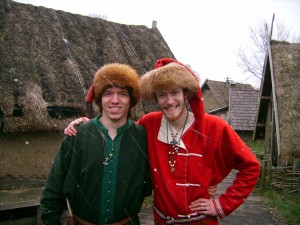
Design: The symmetrical kaftan is an easier cut than the asymmetrical, as it is essentially just a slightly long tunic that’s been cut all the way down the middle. Re-enactors normally slit the kaftan up the rear, as it probably originated as a riding coat and a rear slit make riding easier.
Based on the evidence from the Valsgärde grave, several re-enactors use standing collars on their kaftans rather than conventional tunic neck-openings.
Accessories: Swedish and Gotlandic Vikings had closer links with the East than Norse/Danes, and seem to share many characteristics with the Rus described above. Baggy trousers are shown on Gotland picture stones, and silver granulated beads are common in Gotland silver hoards. All these can be used to emphasis the more Eastern-facing culture of the Swedish Vikings, and to distinguish them from Danes and Norse.
Resources:
- Peter Beatson of Miklagard in the New Varangian Guard has photos of his wonderful symmetrical Birka-style kaftan, along with useful patterns: http://www.miklagard.nvg.org.au/costume/rus/trader/rus_main.htm
- A Medieval Wardrobe shows photos and a pattern for a kaftan. Their photos show a particularly good button arrangement, similar to nomadic frogging (but the red thread could be a bit longer?) However ideally the neck hole should be smaller: http://www.gelfling.dds.nl/viking%20kaftanm.html
- Thor Ewing’s Viking Clothing (p.108-109) discusses kaftans.
Female Coats
History: Female coats are fairly conjectural, and largely based on the evidence of broaches. In Viking finds, as well as the pair of tortoiseshell broaches that hold up the hanging dress, many graves include a central trefoil or circular broach (or, for Gotlandic ladies, a box-shaped broach). These may have held together coats, or they may have held together a shawl.
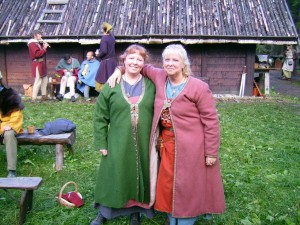
There is some evidence for a different style of female coat in an earlier period to DAS, a Continental style that was popular in Kent in the 6th century.
Design: There is no definitive evidence, iconographic or archaeological, for female coats in the main DAS period. If they exist at all, the archaeological evidence suggests they were held together by a central broach- there are no female graves with buttons that I know of. Some re-enactors have cut them as basically the same as the male symmetrical kaftan, whilst others have modified them slightly by rounding off the bottom front corners.
Women interested in the 6th century Kentish/Continental coat should consult Penelope Walton Rogers’s book.
Accessories: Viking female coats (if they exist) don’t come from any particular region so can be combined with any female Viking costume.
Resources:
- A Medieval Wardrobe has photos of a coat, along with pictures, patterns and quotes gathered from lots of other sources. If you want to make a female coat, this is the only site you need: http://www.gelfling.dds.nl/
- On the other hand, Thor Ewing’s Viking Clothing (p.50-52) dismisses any evidence for female Viking coats.
- Penelope Walton Rogers’s Cloth and Clothing in Early Anglo-Saxon England (p.190-193) discusses everything you might need to know about the Kentish/Continental coat of the 6th century.
From the 2008 DASmag article by Hauk the Bastard.

